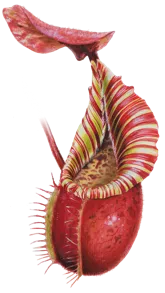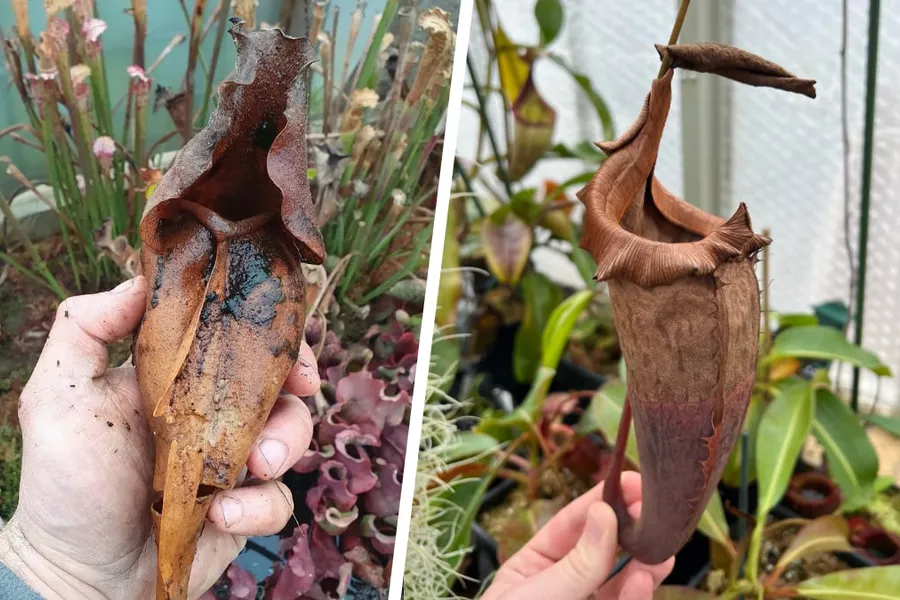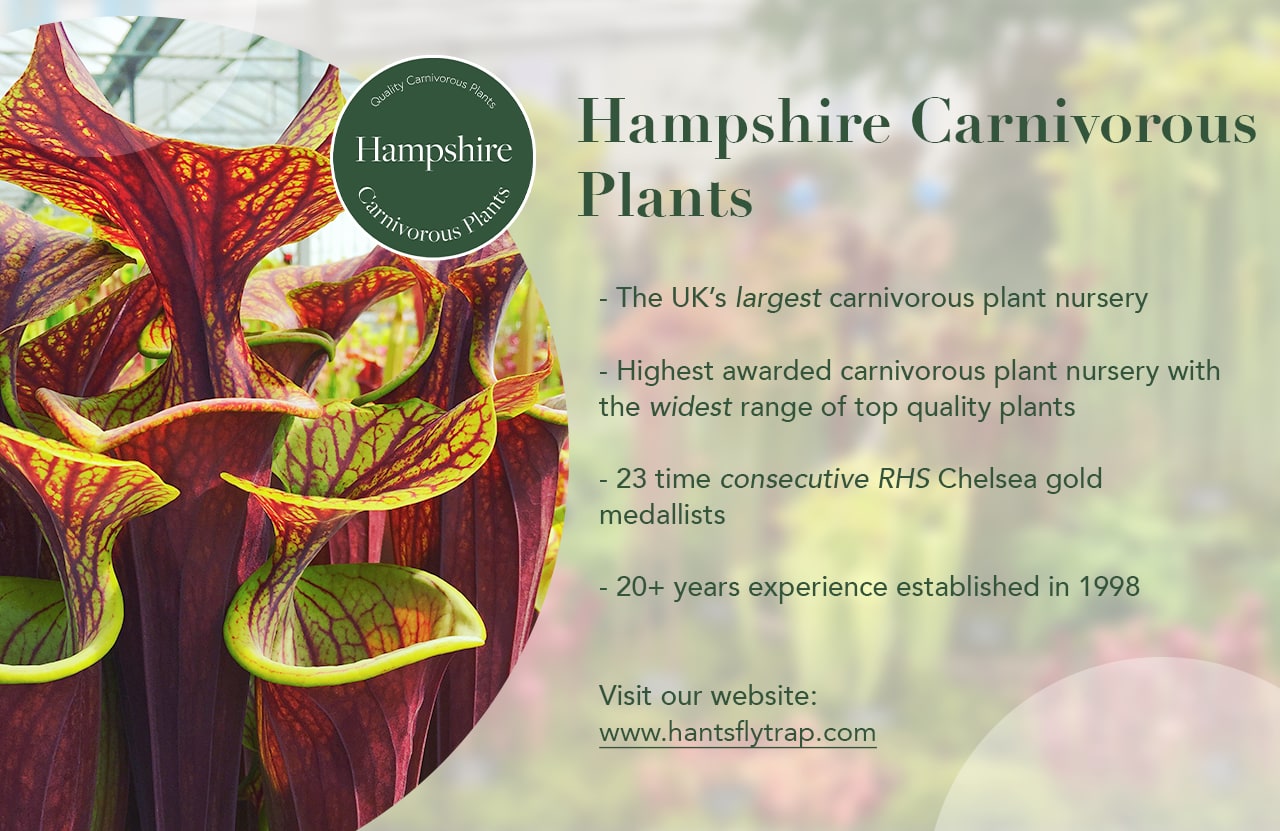If your pitcher plant appears to be declining - leaves turning brown and crispy, growth dying back - don’t panic. This is a common problem, and one which is usually easy to diagnose and fix.
If you search for answers to this question on Google, you’ll find mostly SEO spam: articles written by an AI, or by someone who’s clearly never grown a pitcher plant! Some of the advice in these articles is terrible. Whatever you do, please don’t move your Sarracenia out of direct sunlight, or water your Nepenthes with bottled spring water.
First, identify your pitcher plant!
It’s important to remember there are different ‘types’ of pitcher plant. The two you’re most likely to encounter in garden centres and hardware stores are:
- Trumpet pitchers, or Sarracenia, native to North America. Pitchers grow directly out of the ground, emerging from a central rhizome. Some species have tall upright pitchers which look like trumpets, while others are shorter, squatter, and curved.
- Monkey cups, or Nepenthes, native to the tropics in Southeast Asia. Pitchers inflate at the end of long tendrils which are connected to normal-looking leaves. The plant eventually becomes a scrambling vine.
The solution to brown or dying pitchers is different depending on which genus you’re growing. Shown below on the left is a Nepenthes, and on the right is a Sarracenia.
Click on any photo to zoom in. Use arrow keys or swipe to navigate.
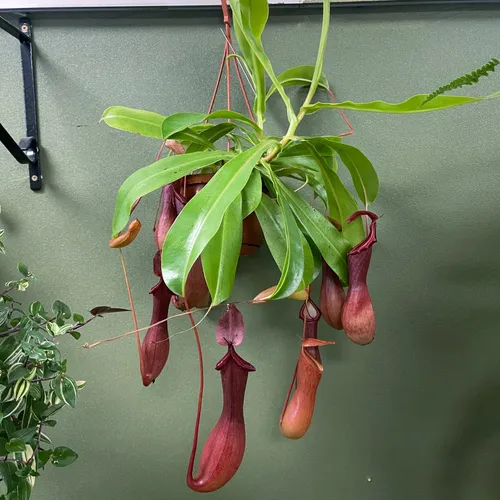 Nepenthes × ventrata, a monkey cup plant
Nepenthes × ventrata, a monkey cup plant 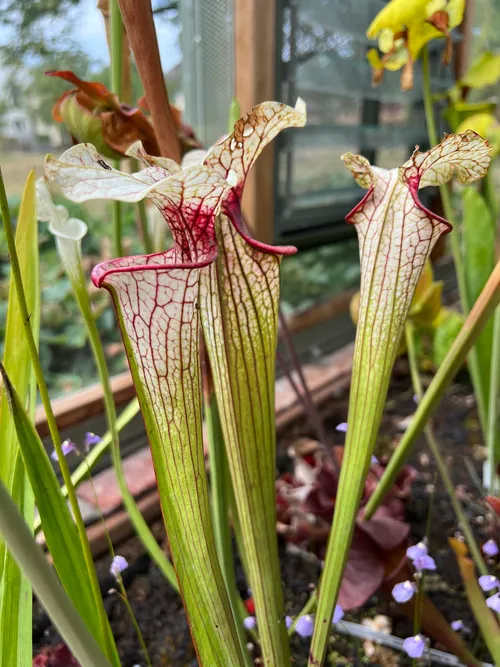 Sarracenia × moorei, a trumpet pitcher plant
Sarracenia × moorei, a trumpet pitcher plant Note that each genus is highly variable - if you want to see more examples of each, I suggest reading my detailed Sarracenia care guide and Nepenthes care guide. These pages include photos demonstrating the wonderful variation within each genus.
Once you know which pitcher plant you have, jump to the appropriate section below.
Top reasons for dying pitchers on Sarracenia
1. Insufficient or inappropriate water
Like many carnivorous plants, Sarracenia evolved to grow in waterlogged, boggy soils very low in nutrients. To cultivate them successfully, you need to replicate their natural habitat. This means that during the warmer time of year (March to October in the northern hemisphere) their pots should be sat in 2-3cm (1 inch) of standing water. That’s right - they should be kept very wet!
What’s more, the type of water you use is also important. Using hard water - including most tap water and bottled water - will cause your trumpet pitchers to rapidly decline and eventually die. This is because the water has more dissolved minerals and salts than they’re able to handle, and this leads to root rot and ill health. You can safely use:
- rainwater
- distilled or deionised water
- water purified with a reverse osmosis system
Note that boiling tap water and letting it cool does not make it suitable for carnivorous plants! I wish it were that easy.
Some people are lucky enough to live in areas where the tap water is naturally low in dissolved minerals. You can test whether you’re one of those lucky people by using a TDS Meter (TDS = total dissolved solids). You’re aiming for a result of under 100 PPM (parts per million), and ideally closer to 50 or below. Suitable TDS Meters are available on Amazon for around £10 / $15.
2. Lack of direct sunlight
Sarracenia are native to the eastern coastal plains of North America and Canada, where they grow in open, sunny wetlands. To cultivate them successfully, you need to provide them with full direct sunlight. A shaded spot will cause your plant to become weak and spindly, with pitchers that lack colour. Eventually the pitchers will go brown and die.
Click on any photo to zoom in. Use arrow keys or swipe to navigate.
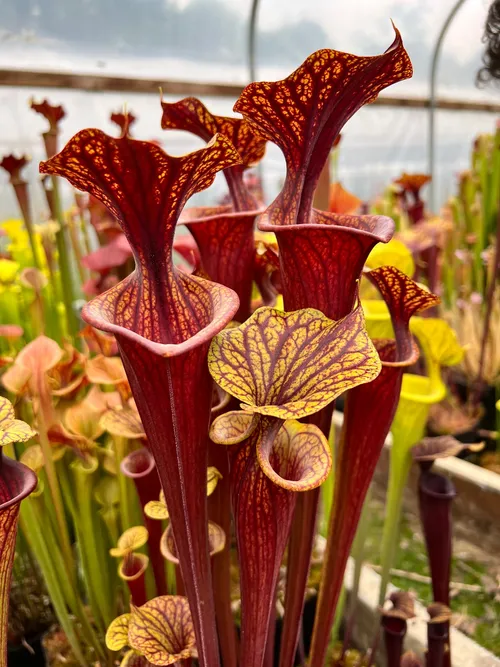 Sarracenia flava, a trumpet pitcher
Sarracenia flava, a trumpet pitcher 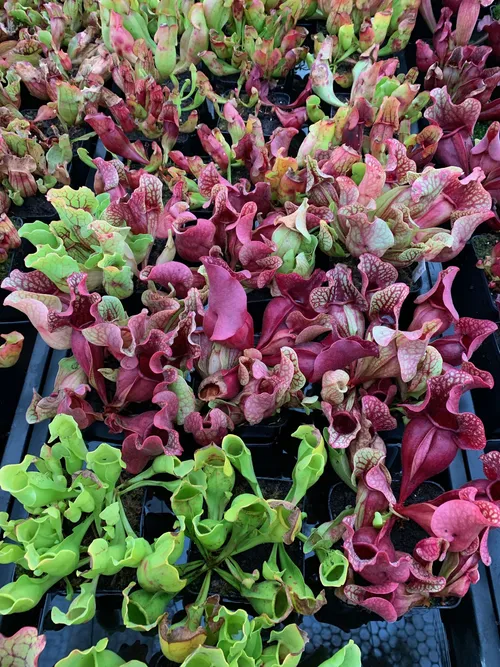 Sarracenia purpurea, the purple pitcher plant
Sarracenia purpurea, the purple pitcher plant If you live in the northern hemisphere (e.g. the US or the UK), you should grow your Sarracenia in the sunniest spot you can find. A south-facing windowsill, a greenhouse, or a conservatory can be ideal. Bathrooms, partially-shaded windowsills, terrariums (even with artificial light), and other such locations are generally not suitable.
3. Natural lifecycle / dormancy
Sometimes, brown crispy pitchers and dying growth can be completely normal.
Sarracenia pitcher plants are flowering perennials, and they need a cold winter dormancy between November and February. In their natural habitats, winter temperatures get down to below freezing (0°C / 32°F). To successfully cultivate your plants in the long-term, you need to give them a cold rest period every winter.
As the daylight hours get shorter and temperatures drop, the pitchers on your plant will turn brown and die back. This is normal, and nothing to worry about. As long as you’re providing suitable winter conditions, you can safely trim off any dead growth and get excited about the start of the new season in Spring.
Click on any photo to zoom in. Use arrow keys or swipe to navigate.
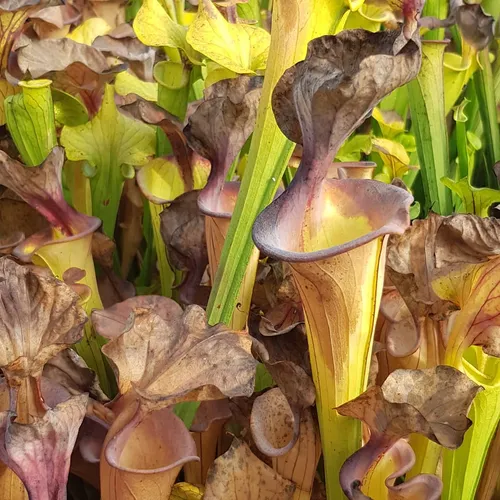 Old growth on Sarracenia flava, photo by Tom Skinner
Old growth on Sarracenia flava, photo by Tom Skinner 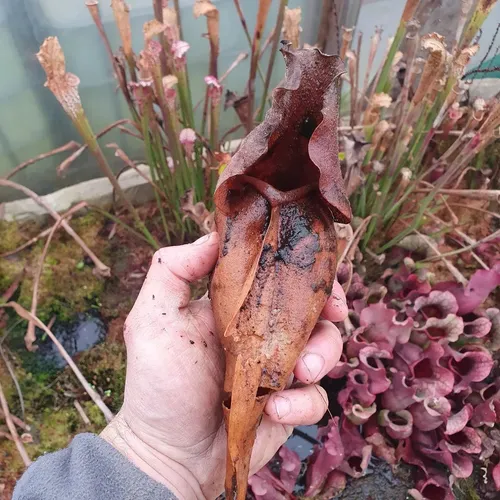 Old growth on Sarracenia purpurea, photo by Tom Skinner
Old growth on Sarracenia purpurea, photo by Tom Skinner You can continue reading about good Sarracenia cultivation - including tips on winter dormancy, sun, and water - in my free guide to growing trumpet pitchers.
Top reasons for dying pitchers on Nepenthes
1. Too much direct sunlight
This is the most common mistake I see.
Unlike the Sarracenia pitcher plants of North America, Nepenthes pitcher plants can burn if exposed to too much direct sunlight. They’re native to the tropics of Southeast Asia, and most Nepenthes species are montane plants that need warm days, cool nights, and high humidity all year round. They benefit from lots of bright light, but you should avoid giving them too much direct sun.
Most Nepenthes you’ll find in garden centres and hardware stores are hybrids, and these are generally far more tolerant than most pure species (of which there are over 170 known to science). If you’re growing on a windowsill, I recommend trying an east or west-facing window that receives direct sun for part of the day. If you’re growing in a greenhouse or conservatory, around 50% shade is ideal.
If your Nepenthes is getting a lot of direct sunlight, it’ll be better able to cope with it if the humidity is quite high, which brings us onto the next reason…
2. Dry soil or low humidity
Nepenthes like it damp but not wet. While Sarracenia pitcher plants grow in boggy soils that remain waterlogged throughout the growing season, Nepenthes prefer a loose, airy, well-draining soil that’s kept just moist year-round. If you’re in the US, I recommend California Carnivores’ premium mix for Nepenthes.
Generally, you want to avoid either extreme:
- letting your pot stand in water like a Sarracenia will cause root rot
- letting the soil dry out completely will cause leaves and pitchers to dry out and die
While we’re on the subject of moisture for Nepenthes, it’s important to remember that they also benefit from high humidity - around 60% to 70% during the day. Dry air can cause pitchers to prematurely dry out and die, and lead to a lack of new pitchers forming. Check out that linked post for tips on raising ambient humidity.
Click on any photo to zoom in. Use arrow keys or swipe to navigate.
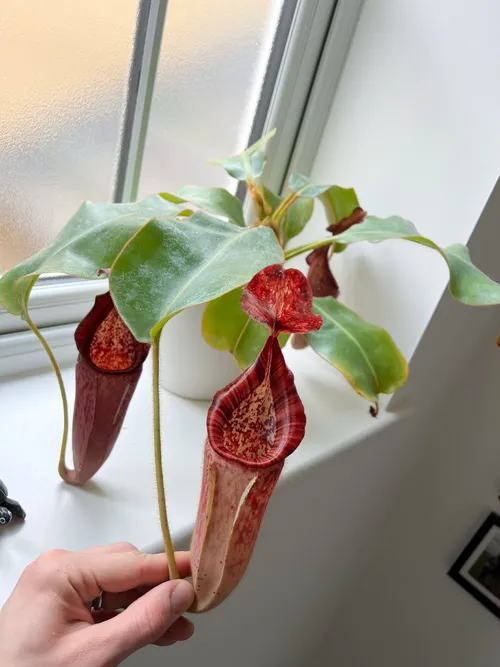 A Nepenthes growing happily on an east-facing windowsill
A Nepenthes growing happily on an east-facing windowsill 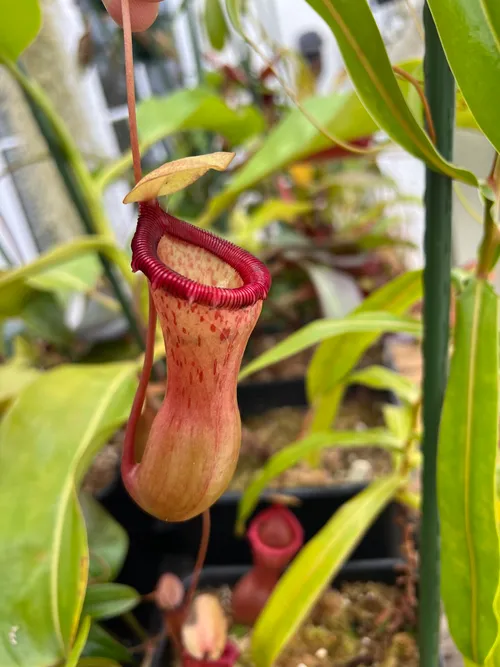 Nepenthes ventricosa, a species I'd recommend for windowsill growing
Nepenthes ventricosa, a species I'd recommend for windowsill growing Some online guides advocate for closer to 100% humidity, such as you might find inside a terrarium. This is not strictly necessary, and can sometimes lead to problems with mould and fungus.
3. Natural lifecycle
As we did with Sarracenia, we’ll finish up with some completely normal reasons why pitchers can turn brown and crispy.
While Nepenthes plants can grow year-round (i.e. they don’t require a winter dormancy), each leaf and pitcher has a finite lifespan. This varies based on the species, the amount of food it catches, the conditions in which your plant is grown, and various other factors:
- Species with tough, woody pitchers (e.g. N. veitchii, N. lowii, and their hybrids), tend to last for longer than species with thin, papery pitchers (e.g. N. aristolochioides, N. hamata).
- Pitchers that have caught a lot of insects will tend to die back sooner than those which have caught little. One sign that a trap has caught enough is that the top of the pitcher will turn brown, while the lower portion (the ‘stomach’ containing the digestive fluid) remains alive, presumably continuing to digest its prey.
- Plants grown under natural light in the northern hemisphere (i.e. exposed to shorter photoperiod of winter) will often drop their pitchers in response to the lack of light. This generally isn’t anything to worry about - reduce watering, and vegetative leafy growth should continue, albeit slowly. Pitcher production should resume in Spring.
Here’s an example of pitcher lifecycle on N. veitchii x platychila. The left photo shows the pitcher today - note how how the upper portion of the trap has turned brown and crispy. The right photo shows it 6 months ago, shortly after it opened, its colorful peristome inviting insects into the trap.
Click on any photo to zoom in. Use arrow keys or swipe to navigate.
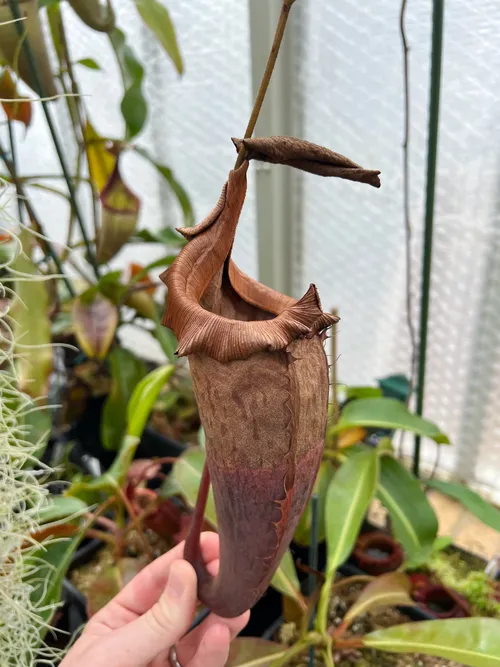 N. veitchii x platychila, a brown pitcher 6 months later
N. veitchii x platychila, a brown pitcher 6 months later 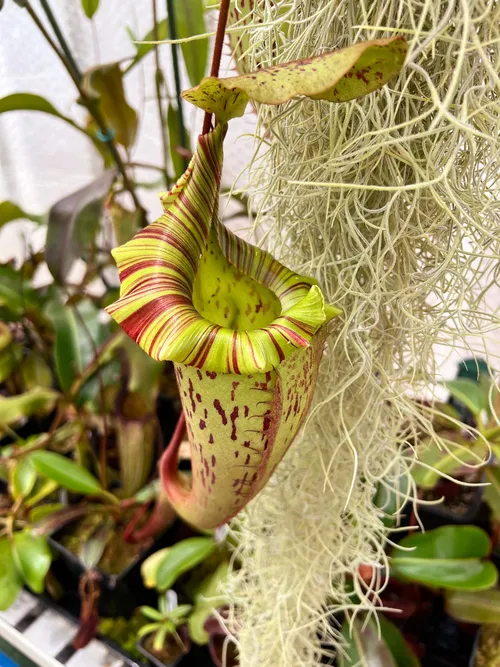 N. veitchii x platychila, a fresh pitcher
N. veitchii x platychila, a fresh pitcher Wrapping Up
Hopefully this guide’s given you some pointers as to why your pitcher plant is turning brown or appearing to die back. To learn more, I’d recommend reading my free Sarracenia care guide and Nepenthes care guide, each of which go into a lot more detail on various aspects of pitcher plant cultivation.
If you’re in the market for a new pitcher plant or for growing supplies like compost, I wholeheartedly recommend California Carnivores. They have a huge range of Sarracenia and Nepenthes pitcher plants available for delivery throughout the United States, as well as suitable companions plants.
You can also get 10% off your order with the code tomscarnivores.
If you’re in the UK and looking for a new pitcher plant or ready-made compost mixes, I recommend you head over to Hampshire Carnivorous Plants. They sell a variety of both Sarracenia trumpet pitchers and Nepenthes monkey cups, as well as accessories like compost.
Thanks for reading! Happy growing.
